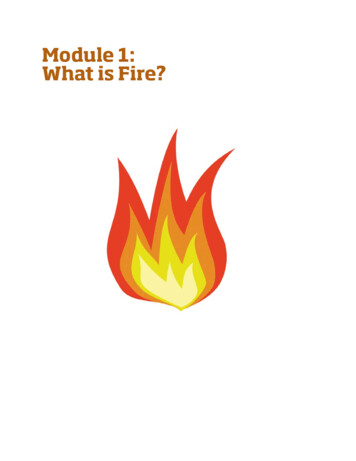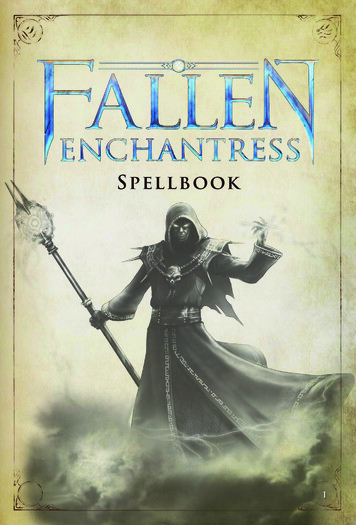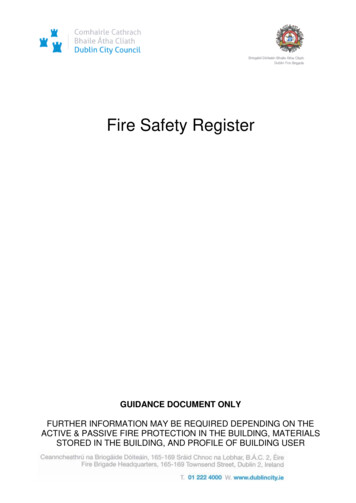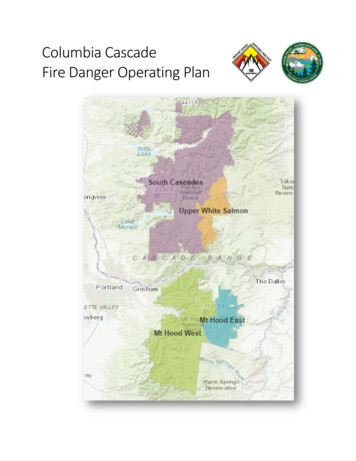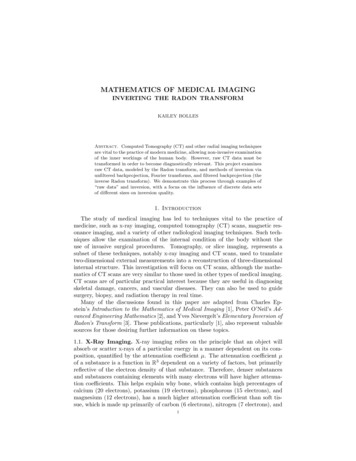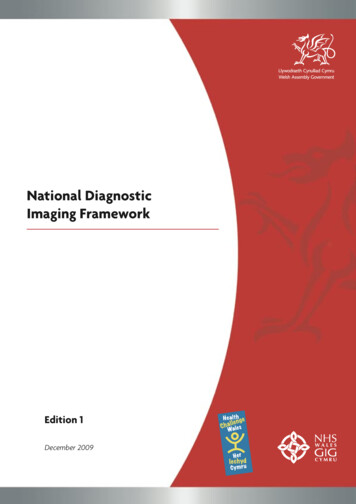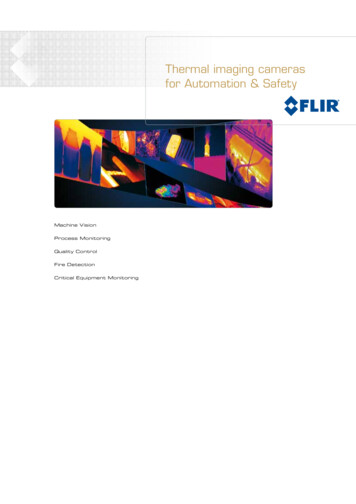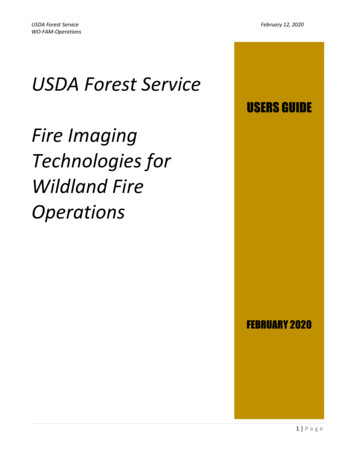
Transcription
USDA Forest ServiceWO-FAM-OperationsFebruary 12, 2020USDA Forest ServiceUSERS GUIDEFire ImagingTechnologies forWildland FireOperationsFEBRUARY 20201 P a ge
USDA Forest ServiceWO-FAM-OperationsI.February 12, 2020IntroductionFor 50 years the wildland fire community has used thermal imaging to map wildland fires. Agency aircraftequipped with infrared (IR) sensors under the Forest Service’s (FS) National Infrared Operations (NIROPS)program have been the mainstay collection platforms for over 40 of those years.In the last 10 years additional fire imaging technology and capabilities have become available to the wildland firecommunity, much of it stemming from the U.S. government, both civil and defense, as well as private industry.The following is a brief timeline of IR capabilities used to support wildland fire operations: In 1969 the Forest Service began to use IR sensors on manned aircraft, which later became NIROPS In the mid-1990's national system collection platforms became available as surge capacity for NIROPS In the early 2000’s NASA earth observation satellites Aqua and Terra became available with theModerate Resolution Imaging Spectroradiometer (MODIS) active fire detection In 2003 the Forest Service introduced the Firewatch Cobra helicopter program equipped with electrooptical (EO) and infrared (IR) sensors coupled with data transfer technology In the mid-2000’s there were some first-attempts at using National Guard unmanned aerial vehicle(UAV) on wildfires for information gathering In 2012 the Suomi National Polar-orbiting Partnership (NPP) and NOAA-20 satellites became availablefeaturing the Visible Infrared Imaging Radiometer Suite (VIIRS) In 2012 the Forest Service introduced the Enterprise Geospatial Portal (EGP) as a dashboard display forfire information gathered from various data sources, including satellite collections In 2013 Forest Service introduced the NightWatch program equipped with EO/IR sensors In 2014 the Colorado State’s Division of Fire Prevention and Control (DFPC) introduced their MultiMission Aircraft (MMA) program equipped with EO/IR sensors along with data transmission capabilities In 2015 an MOU between the Forest Service and Department of Defense allowed use of Air NationalGuard Distributed Real Time IR (DRTI) aircraft with data streaming capabilities In 2016 the Forest Service contracted with private sector vendors to provide aircraft equipped withEO/IR sensors In 2018 the Bureau of Land Management (BLM) hosted the first contracts for large Unmanned AircraftSystems (UAS) equipped with EO/IR and downlink capabilities In 2019 the Forest Service contracted additional aircraft equipped with IR sensors to provide surgecapacity for NIROPS In 2020 the Forest Service continued expanding use of contract aircraft to provide IR imagingDuring this time the wildland fire community, with input from the Forest Service remote sensing program,governmental agencies and private industry, has been continuously evaluating how best to use airborne andspace-based platforms to gather intelligence and integrate IR data into fire operations to improve situationalawareness and support strategic and tactical decisions.A. Incident Awareness and Assessment (IAA) Defined:Incident Awareness and Assessment (IAA) is similar to the Department of Defense’s definition of Intelligence,Surveillance, and Reconnaissance (ISR). However, ISR is conducted outside of the United States over foreignterritories or within the United States during Homeland Defense events, while IAA is conducted within theUnited States in support of Defense Support of Civil Authorities (DSCA) operations (e.g. natural disasters). IAAfocuses on providing timely and usable information to all levels of command and to local, State, Civil, and2 P a ge
USDA Forest ServiceWO-FAM-OperationsFebruary 12, 2020Federal leaders in order to save lives, reduce human suffering, and protect property. IAA capabilities includeelectro-optical (EO), infra-red (IR), and Full Motion Video (FMV).The wildland fire community has similar needs for IAA. Information gathered from collection platforms providescritical situational awareness for fireline personnel, Incident Management Teams (IMT), fire managers, andagency administrators to inform tactical and strategic decisions. Systems intended for wildland fire operationsare evolving and range from small hand-held devices, sensors on manned and unmanned aircraft, and satellites.IR collection platforms currently in use include:IAA Aircraft Systems: FS National Infrared Operations (NIROPS) FS FireWatch Helicopters FS NightWatch Colorado DFPC Multi-Mission Aircraft (CO-MMA) Air National Guard Distributed Real Time Infrared (DRTI) California National Guard MQ-9 Reaper Unmanned Aerial Vehicles (UAV) Private sector manned fixed wing aircraft equipped with camera-ball or nadir-looking EO/IR camerasystems under contract to federal, state, or local government agencies Unmanned Aircraft Systems (UAS) ranging from commercially available small UAS with limitedendurance to large private sector UAS with long endurance and sophisticated EO/IR sensorsIAA Satellite Systems: NASA earth observation satellite Aqua and Terra featuring MODIS active fire detection NOAA and Suomi NPP satellites featuring the VIIRS-I and VIIRS-AF band for heat detection NOAA Geostationary Operational Environmental Satellite systems (GOES-16/17) featuring IR andlightning detection capabilities FS Ignition Point (IgPoint) program displaying thermal detection data in the Enterprise GeospatialPortal (EGP) for new fire starts Commercial satellites that have high resolution thermal detection capabilitiesField demand for overhead imagery data to inform strategic and tactical decision making is on the increase,especially as end-users realize the potential and are able to integrate it into their operational planning cycles.However use of this technology cannot be supported without operational objectives and requirements whichwould support innovation, developing technology, and broader use of fire imaging and technology systems.B. Fire Imaging TechnologiesAircraft equipped with IR systems can be loosely divided into two broad categories, Electro-Optical/Infrared(EO/IR) camera ball systems and Line Scanner/Step-stare IR camera systems equipped with multi-spectral arraysincluding thermal bands.1. Electro-Optical/Infrared (EO/IR) Camera Ball Systems:Systems that incorporate a high resolution EO/IR camera array mounted in a steerable gimbal mountedturret are commonly used for IAA missions. The combination of EO and IR cameras allows the operatorto switch back and forth between visual and IR modes to identify and distinguish targets on the ground,and includes zoom capability. EO/IR camera balls are typically mounted beneath the aircraft and can beaimed by the operator in any downward direction regardless of direction of flight.3 P a ge
USDA Forest ServiceWO-FAM-OperationsFebruary 12, 2020Capabilities of EO/IR camera systems vary by the manufacturer and model used. Mid-wave IR (MWIR)and/or Long-wave IR (LWIR) are the most commonly used bands for wildland fire operations to capturehigh-resolution thermal imagery. Some camera systems may be cooled and can filter out extraneousheat signatures, improving the imaging and detection capabilities. When EO/IR cameras are paired withmapping and navigation software these systems are capable of providing highly accurate map productsshowing location of active heat perimeters, spot fires, new starts, and generate KMZ, KML and/or GISshapefiles.EO/IR camera ball systems can be flown at varying altitudes ranging from low level to 20,000 feet aboveground. The acquisition altitude is typically governed by the need to avoid conflict with tactical aircraftoperating in the incident’s Fire Traffic Area (FTA) as well as gain a wider perspective.Due to the higher resolution, EO/IR camera ball systems are very effective tools for providing overwatch for specific areas of interest on a wildland fire, detecting spot fires or new fires, providing supportfor a ground operation (i.e. burn out or line construction), monitoring impingement of trigger points,and identifying location and amount of residual heat during the mop-up phase. Most cooled EO/IRcamera systems have the sensitivity to detect body heat, and can be used to spot individuals or animalson the ground. Aircraft with EO/IR camera ball systems can be used to map fires, however due to thenarrower field of view it generally takes longer to map a fire than other systems such as Line Scanner orStep-Stare camera systems (see below).2. Line Scanner / Step-Stare IR Camera Systems:Line scanners or downward looking camera systems that employ a step-stare technique are optimized torapidly acquire imagery over a large area. Unlike a camera ball system that uses ‘cursor-on-target’techniques, line scanners and step-stare systems capture imagery in a swath to either side of the aircraftresulting in a wide field of view. Each successive swath along the flightpath is compiled into an imagemosaic showing areas of heat detection, which are then analyzed and processed into map productsshowing perimeter, areas of heat intensity, and location isolated heat sources.Capabilities of these systems vary by the manufacturer and model used. Some systems consist of amulti-spectral array of EO, SWIR, MWIR, LWIR, and NIR bands to generate an image mosaic. Othersystems just use LWIR and NIR. When combined with navigation and mapping software, highly accuratemap products can be constructed for further use by fire managers.The line scanners used by Forest Service NIROPS aircraft use rotating mirrors to reflect thermal IR to theMWIR-LWIR scan head in a wide swath on either side of the flight path. The successive lines arecompiled into a high-resolution imagery showing heat detection from which highly accurate mapproducts are produced.Aircraft equipped with these sensors typically fly a series of passes over the fire, similar to mowing alawn. The field of view of each pass is dependent on the altitude, which in turn is determined by thesensitivity of the sensors and the capabilities of the host aircraft. For optimum coverage, aircraftequipped with step-stare or line scanners will typically conduct missions from 10,000 to 18,000 feetabove ground, well above the Temporary Flight Restriction (TFR).The advantage to these systems is the high scan volume (acres per hour), capable of scanning up to400,000 acres per hour, depending on the altitude and speed of the host aircraft. Even on the low end,these scan volumes are significantly higher than an aircraft equipped with EO/IR camera ball. As a4 P a ge
USDA Forest ServiceWO-FAM-OperationsFebruary 12, 2020result, these systems are better suited for mapping large fires in a short amount of time. Depending onthe speed and range of the host aircraft they can map numerous large fires spread out over ageographic or multiple geographic areas in a single operational period.II.Operational NeedsIR collection platforms available for wildland fire operations are increasing in number and capabilities. Realworld operational experiences over the last few years have shown that not all platforms possess the samecapabilities, products or services. Actual practice has shown that certain combinations of platform and sensorare better suited for one mission type while other combinations may be better suited for another, but there alsoexists some overlap in capabilities.The purpose of this guide is to identify the primary types of IR capabilities that are needed to support wildlandfire operations, by identifying key differences in technologies, and to provide assistance to Fire Managers inselecting the best tool for the job based on end-user requirements.A. Discussion PointsDemand for IR intelligence to support strategic and tactical operations is growing, as are the different types of IRsystems that are becoming available to the wildland fire community. At current levels the number of IRcollection platforms is still relatively finite. During higher preparedness levels (PL) requests for overhead imagerymay exceed collection capacity resulting in the need to be prioritized at the GACC and National levels.Determining the end-user’s information requirements should be the first step for fire managers. As the numberof options for IR platforms increase, it is important to recognize that some platforms are better suited for aparticular mission over others. As such, identifying what the end-user needs, how they intend to use theinformation, and how often it is needed will ultimately assist with selecting the best tool(s) for the job.Polling of incident management personnel in late 2017 revealed a preference for GIS-ready map products asopposed to raw imagery, pictures, or full motion video (FMV). While pictures or FMV are useful for tacticalpurposes, the majority of responses indicated that map products such as KMZ, KML, and GIS shapefiles were inmuch higher demand and had much more long term value. Video streaming in the IR spectrum has beensuccessful in locating spot fires, monitoring burn out operations, providing situational awareness of fire activitywhen obscured by the smoke column or inversions, and has also been used to gauge fire behavior and calibratefire spread models. However, monitoring live video streaming by ground personnel can be laborious and requireadditional personnel and/or proprietary data link equipment especially in areas of limited or no wifi or cellularconnectivity.B. Infrared Missions to support Wildland Fire OperationsThe Forest Service Fire and Aviation Management (FAM) has identified four types of missions that IR collectionplatforms play a key role in providing support for wildland fire operations and decision making. The fourmissions are described in Figure 1 below.5 P a ge
USDA Forest ServiceWO-FAM-OperationsFebruary 12, 2020Figure 1. Fire Imaging Missions to Support Wildland Fire OperationsMission DescriptionDetection: Aircraft (AC) or satellitesystem equipped with thermalsensors that can detect new fires. Improve response times andprovide for public safety Discriminate false positives Assist with risk assessment andGo / No-Go decisionsCurrent Capabilities DRTI, CO-MMA, NightWatch, andcontract A/C Scan large area post lightningevent i.e. national forest or GACC Derive GPS location data andmaps of new fires EGP’s IgPoint is being refined for24/7 detectionLarge Fire Perimeter Mapping: ACequipped with thermal sensors areused to derive incident map data(perimeter, heat stratification, acres)to update incident maps, SA, informstrategic and tactical decisions, etc. Map 50-70 large fires per 24 hrs National coverage NIROPS primary roleAgency ACAdditional capacity to supportNIROPS with contractors will bein place for 2020Best Use AC with EO/IR camera ball maybe best use Order when lightning event isforecasted or has occurred AC w/ EO can differentiate firefrom false positive Tactical Incident Awareness andAssessment (IAA): Thermal imageryfrom AC is used throughout theoperational period to acquireadditional intelligence on fast movingdynamic fires, and/or in closeproximity to values. Update SA, monitor spread, andsupport tactical operations Day or Night updates Persistent or Periodic coverage Provide real-time alerts Updated map products Map fires in support of, or in lieuof, NIROPSStrategic Intelligence (Dashboard):Maintain a Common OperatingPicture to provide situationalawareness of fires nation-wide. Satellite IR data, fire perimeters,resources, etc. Inform strategic decisions (nontactical) Prioritize response and resourcesPersistent IAA: 12-18 hrs on-demandcoverage for single fire Large UAS or FireWatchhelicopter role Dedicated coverage of one firePeriodic IAA: 1-2 hrs of coverage formultiple fires Manned aircraft role (AA-51, COMMA, DRTI, contract AC, etc.) Can be assigned to covermultiple fires in one operationalperiodEGP dashboard display: MODIS and VIIRS detections IgPoint detections HDDS commercial satelliteimagery (when available) Import fire perimeter maps Regional and National leveldecision support Large Fires: NIROPS line scannerand step-stare IR camera systemsare best use for large fires atnightSmall Fires: AC with EO/IRcamera balls are capable ofmapping fires 1,000 acres intimber or 10,000 acres in lightfuelsDesert Fires: AC with EO/IRsensors during daytime hours isbest useAC equipped with EO/IR cameraball may be best useLarge UAS may be best use toprovide persistent day and nightcoverage of a single fireManned AC is best use toprovide periodic coverage ofmultiple firesNumber of fires manned AC cancover is limited by range andspeed of the ACSatellite detection may be bestuse for nation-wide coverageCombine with additional datafrom other sources (i.e GEOMAC)6 P a ge
USDA Forest ServiceWO-FAM-OperationsIII.February 12, 2020Comparison of CapabilitiesFigure 2. Comparison of capabilities of different IR collection platformsType ofSensorIRCapabilityDay orNightMapProductsCostBest UseFS NIROPSLine ScannerDual Band IR(MWIRLWIR)NightGIS ReadyShapefiles,KMZ, and PDFMapNo 1150/hrKing AirMapping multiplelarge fires acrossmultiple Geo AreasFS NIROPSContractedCapacity1Step-stareEO/IRsystemsIR bandsvary byvendorNoDay orNightGIS ReadyShapefiles,KMZ, and PDFMapVaries byvendorMapping multiplelarge fires acrossmultiple Geo AreaDRTIEO/IRCamera BallIR, EOYes, viaJTACDay orNightLat/Long ofheat detectionpointsNoneDetection and IAACO-MMAEO/IRCamera BallIR, EOYes, via COWIMSwebsiteDay orNightGIS ReadyShapefile, KMLand PDF Map 1800/hrDetection and IAAMapping fires 10KacresFS NightWatchAA51EO/IRCamera BallHD IR andEO, Laser.Yes, viaMPU5radio linkNightGIS ReadyShapefiles,KMZ, and PDFMap 2249/hrDetection, IAA, andmapping small firesor portions of largefiresFS FireWatchCobraEO/IRCamera BallHD IR andEO, Laser.Yes, viaMPU5radio linkDayGIS ReadyShapefiles,KMZ, and PDFMap 2800 perhr. includesATGS, datavanIAA and mappingsmall fires orportions of largefiresIR, EOVaries byvendorDay orNightVaries byvendorVaries byvendorDetection, IAA, andmapping fires smallfires or portions oflarge firesPlatformVendorprovidedIAA212EO/IRCamera BallVideoSteamingNIROPS will be augmented with contractors providing additional capacity.Vendors on contract to provide IAA capabilities. FS has contract for manned aircraft, BLM has contract for large UAS7 P a ge
USDA Forest ServiceWO-FAM-OperationsIV.February 12, 2020Consideration for UseFire SituationLarge Wildfire (active) Containment objectives not met Fire is actively spreading andincreasing in size Primary control objectives are tocontain/confine fire and/orprotect VARsEnd-User RequirementsMap products needed: PDF geo-rectified map of heatperimeter Areas of intense, scattered,isolated heat GIS Shapefiles and KMZ/KML IR LogBest Use ConsiderationsOrder NIROPS via online request form Request will be assign to one ofthe NIROPS aircraft, includingcontractors NIROPS AC have scan volume of100,000 to 400,000 acres/hourLarge Wildfire (very active w/ VARs) Containment objectives not met Fire is very active and is spreadingtowards VARs Fire has exceeded or anticipatedto exceed trigger points / MAPs Additional daytime SA is neededto monitor MAP impingement,i.e. evacuation trigger pointsService/Map products needed: Same map products as above Additional updates during the day(periodic or persistent) areneeded Ability to quickly transferinformation or data to incidentConsider ordering: NIROPS for once-per-night update–and IAA platform equipped with EO/IRsensors for daytime update(s) If persistent IAA is needed,consider ordering large UAS ordedicated IAA platform w/ datalink and radio communicationLarge Wildfire (not active) Containment objectives havebeen met or nearing completion Forward movement of fire hasbeen halted Minimal increase in size / activity Character of the fire is primarilysmoldering Primary operation is mop-up andpatrol Minimal change from previous 24hrsService/Map products needed: Map products showing amountand location of residual heat Monitor residual heat near toVARs or MAPs Inform mop-up decisions Entire fire does not need to bemappedConsider ordering: IAA platform equipped with EO/IRcamera-ball (NIROPS is notoptimized for this mission) EO/IR camera-ball has bettersensitivity for smoldering fires EO/IR camera-balls have lowerscan volume 10,000 acres/hour For efficiency specify area ofinterest for scanning (i.e. NEflank, Div W, hillside abovesubdivision, etc. instead of “flythe entire fire”)Large Wildfire (light fuels) IR sensors can only map the heatit detects Fires that burn in light fuels oftenhave portions that go out prior tothe NIROPS nighttime flight. Areas of ‘cold black’ may be hardto distinguish, especially in lightgrass fuels. Only the leading edge of the fireor areas burning in heavier fuelswill show sufficient heat fordetectionMap products needed: PDF geo-rectified map of heatperimeter Areas of intense, scattered,isolated heat GIS Shapefiles and KMZ/KML IR LogConsider ordering: IAA platform with EO/IR for lateafternoon/early evening flight EO camera can distinguish ‘coldblack’ and generate accurate mapof burned perimeter IR sensor will detect heat fromopen flames or smolderingembers even during daytime NIROPS is not optimized to detect‘cold black’8 P a ge
USDA Forest ServiceWO-FAM-OperationsFebruary 12, 2020Fire SituationIsolated Small Wildfire ( 1,000 acresin timber, or 10,000 acres in lightfuels) Containment objectives not met Fire is actively spreading andincreasing in sizeEnd-User RequirementsMap products needed: PDF geo-rectified map of heatperimeter Areas of intense, scattered,isolated heat GIS Shapefiles and KMZ/KMLBest Use ConsiderationsConsider ordering: IAA platform w/ EO/IR cameraball If located near other large firesthat are being flown by NIROPS,NIROPS may be a good fitPost Lightning Storm Fire Detection Lightning data or forecastindicates widespread lightningactivity occurring or expected tooccur across a large area Concern with locating hold-overfires and/or new starts in smokyconditionsService/Map Products needed: Day or night scan of areaimpacted by lightning storms(based on lightning detection) GIS shapefiles (points) of newstarts, including KMZ or KML Basic size up information,including if fire is staffed or not Map any perimeter 10 acresConsider ordering: IAA platform equipped with EO/IRcamera-ball Size of scan area may dictate typeof AC used (speed and range) Will need to identify central POCfor dissemination of IR data (i.e.GACC or EOC) along w/ GISSsupport to exploit and display GISdata9 P a ge
USDA Forest ServiceWO-FAM-OperationsFebruary 12, 2020Appendices: IAA Aircraft Systems for Wildland FireThe following appendices identifies IAA aircraft systems available for wildland fire support. The list in notinclusive of all the options and there are a number of vendors on various contracts or agreements that may beavailable to provide similar IR mapping or over watch services. The IAA systems described in this guide primarilyfocus on wildland or cooperating agency aircraft systems.Appendix A: USFS National Infrared Operations (NIROPS)Appendix B: USFS FireWatch ProgramAppendix C: USFS NightWatch ProgramAppendix D: National Guard Distributed Real Time Infrared (DRTI)Appendix E: California Air GuardAppendix F: Colorado Multi-Mission Aircraft (CO-MMA)10 P a g e
USDA Forest ServiceWO-FAM-OperationsFebruary 12, 2020Appendix A: National Infrared Operations program (NIROPS)The National Infrared Operations (NIROPS) is operated by the US Forest Service to provide IR mapping ofwildfires across multiple geographic areas. NIROPS provides a once-per-24-hour update of the fire’s heatperimeter and distribution of heat within the perimeter. NIROPS consists of agency-owned aircraft equippedwith the Phoenix line-scanner system. Staffed with agency pilots, IR Technicians, IR Interpreters (IRIN) andNational Coordinators (IRCN) the NIROPS program has a workflow that has supported upwards of 49 fires spreadacross multiple geographic areas in a single night.To respond to the increasing demand for NIROPS fire mapping service, the Forest Service is hosting contracts toprovide additional capacity to the NIROPS program using vendor-aircraft equipped with commercial IR sensors.The vendors deliver equivalent IR map services and products as agency NIROPS.Agency-aircraft have a scan volume of 300,000 acres per hour. Vendor-aircraft have a scan volume ranging from100,000 to 400,000 acres per hour depending on the aircraft and sensor used.Deliverables Geo-rectified PDF map showing heat perimeter with areas of intense, scattered, and isolated heat KMZ or KML GIS ready shapefiles compatible with the GSTOP format IR Interpreter’s Log All map products will be posted to the incident’s IR folder on the NIFC-FTP by 0400 hours MDTConsiderations NIROPS is typically flown at night when there is the greatest temperature contrast between the fire andthe ground. Agency-aircraft equipped with the Phoenix Line Scanner are optimized for nighttime operations Vendor-aircraft equipped with EO/IR sensors are capable of providing pre-dusk coverage on a case-bycase basis provided the earlier missions do not impede night time operations on other fires11 P a g e
USDA Forest ServiceWO-FAM-Operations February 12, 2020Daytime flights (early evening before sunset) may be more accurate for fires burning in light fuels tomap ‘cold black’ perimetersIR sensors can only map the heat they detect. ‘Cold black’ perimeters (e.g. fires that burned in fine fuels)are difficult to detect and may require assistance from incident SITL or GISS to provide existingperimeter, or request the mission be conducted pre-duskCloud cover and fog (water vapor) inhibits infrared capability and accuracyCost for IR mapping service varies by aircraft used, size of the fire, as well as proximity to other firesNIROPS aircraft fly above the incidents Temporary Flight Restriction (TFR) at altitudes ranging from6,000 to 18,000 feet above groundIf additional IR missions are needed, consider ordering Tactical IAA collection platforms for additionaldaytime acquisition (see Consideration for Use table in Section IV)Ordering Requests for NIROPS are to be submitted to the online IR scanner order website(https://fsapps.nwcg.gov/nirops) prior to 1530 hours MDT Each day the National IR Coordinator will review the number and location of requests and assign themissions to an aircraft to be flown that evening During high demand periods, fires may be prioritized based on national and geographic area priorities An IR Interpreter (IRIN) will be assigned if the fire is flown by an agency or exclusive use contractedaircraft. Vendors under end product contract will provide interpretation and map products A Resource Order with A-number will be generated in ROSS Once the fire is assigned to an aircraft, the SITL or GISS will be contacted by the IRIN or vendor’sinterpreter to work out any additional details or refine the requestCostAircraftKing Air (N148Z)Citation (N144Z)Vendor Aircraft2020 Flight Rate (Hr) 1,150.00N/AVaries by vendorNotes6 mile swath at 10,000AGLNot available in 2020Varies by vendor12 P a g e
USDA Forest ServiceWO-FAM-OperationsFebruary 12, 202013 P a g e
USDA Forest ServiceWO-FAM-OperationsFebruary 12, 2020Appendix B: USFS FireWatch Program (AA-507, AA-509)The USFS Firewatch Cobra has been providing Incident Awareness and Assessment (IAA) support for over 15years. Equipped with an EO/IR camera ball, the Firewatch Cobra has been able to provide incidents withgeospatial support as well as perform tactical aerial supervision / helicopter coordinator (HLCO) roles. TheFirewatch Cobra will arrive at an incident with a flight crew consisting of a pilot and Air Tactical GroupSupervisor, and is also accompanied by a GIS support van. In the past the Firewatch Cobra has been able tosupply real time situational awareness by transmitting raw imagery through microwave transmissions to alaptop. Now as they continue to test new technologies they are moving toward Mesh Networking capabilitiesthat will be able to provide that same real time situational awareness and stream imagery with imbedded Metadata to the GIS van or line personnel equipped with mesh networking compatible radios.Deliverable Provide over watch in support of ground operations, detect spot fires, and provide aerial supervision inlow visibility conditions Provide perimeter mapping services for smaller fires, or provide map updates for portions of larger fires GIS ready shapefiles and KMZ compatible with the GSTOP format Products can be loaded to the incident’s IR folder on the NIFC-FTP site or incident’s Firenet drive Products, including FMV, can also be provided via thumb-drive14 P a g e
USDA Forest ServiceWO-FAM-Operations February 12, 2020If mesh networking capability can be established on the incident, FMV raw imagery can be transmittedto field personnel equipped with compatible radiosAble to cover multiple fires, if within close proximity. However with short fuel durations this is not idealNear Real Time Awareness Information captured by the platform is recorded and then processed after landingo Latency could be up to 3 hrso This will change as Mesh Network capability is stood up Inflight tasking can be provided during flights through radio communicationo Will be monitoring incident frequencies and can provide information updates to groundpersonnel EO camera can take color photos of areas of interest on the fireo These can be recorded and processed after landing or transmitted through Mesh Network Infrared Camera can take snapshots of areas of interest on the fire and be display the same as EO Video can be taken from either the EO camera or the Infrared camera to display
Wildland Fire Operations . USERS GUIDE . FEBRUARY 2020 . USDA Forest Service February 12, 2020 . Incident Management Teams (IMT), fire managers, and . Aircraft equipped with these sensors typically fly a series of passes over the fire, similar to mowing a lawn. The field of view of each pass is dependent on the altitude, which in turn is .


